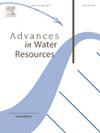Integrating analytical solutions and U-Net model for predicting groundwater contaminant plumes in pump-and-treat systems
IF 4.2
2区 环境科学与生态学
Q1 WATER RESOURCES
引用次数: 0
Abstract
Pump-and-treat (P&T) is a common technique for groundwater remediation involving the extraction and treatment of contaminated water above ground. Optimizing the design and operation of the P&T well network is essential for maximizing the system’s effectiveness and efficiency. However, this optimization often necessitates many model evaluations, leading to computationally demanding tasks. This study introduces a novel approach that integrates analytical solutions for groundwater dynamics with the U-Net deep learning framework to predict groundwater contaminant plume migration under dynamic pumping conditions. By incorporating the Thiem equation into the input preprocessing, the U-Net model transforms sparse well data into a continuous spatial field that captures the hydraulic impacts of pumping activities. This integration enables the model to leverage both deep learning capabilities and classical physics-based groundwater theories, enhancing prediction accuracy and computational efficiency. For example, in 2D synthetic cases, integrating analytical solutions reduced the RMSE from 2.76 µg/L to 0.7 µg/L. In a complex 3D heterogeneous model of the Hanford Site’s 200 West P&T facility, our trained surrogate model completed a 12-year simulation in just 600 ms on a single CPU core, achieving an accumulative RMSE of <1.6 µg/L—an improvement of over three orders of magnitude in simulation speed compared to a numerical model. These advancements support rapid evaluations of P&T optimization scenarios, enabling timely and effective decision-making for well placement and system management. Our findings highlight the potential of advanced machine learning models to significantly enhance the efficiency and sustainability of groundwater remediation efforts, offering a novel application of the U-Net architecture in environmental science.
综合分析解决方案和U-Net模型预测地下水污染羽流在泵和处理系统
抽水处理(P&;T)是一种常见的地下水修复技术,涉及提取和处理地面上受污染的水。优化P&;T井网的设计和操作对于最大限度地提高系统的有效性和效率至关重要。然而,这种优化通常需要许多模型评估,从而导致计算要求很高的任务。本研究引入了一种新的方法,将地下水动力学的分析解决方案与U-Net深度学习框架相结合,以预测动态抽水条件下地下水污染物羽流的迁移。通过将Thiem方程整合到输入预处理中,U-Net模型将稀疏的井数据转换为连续的空间场,从而捕获泵送活动的水力影响。这种集成使模型能够利用深度学习能力和基于经典物理的地下水理论,提高预测精度和计算效率。例如,在二维合成情况下,整合分析溶液将RMSE从2.76 μ g/L降低到0.7 μ g/L。在Hanford Site的200 West P&;T设施的复杂3D异构模型中,我们训练有素的代理模型在单个CPU核心上仅用600 ms完成了12年的模拟,累计RMSE为<;1.6 μ g/ l,与数值模型相比,模拟速度提高了三个数量级以上。这些进步支持P&;T优化方案的快速评估,能够及时有效地为井位和系统管理做出决策。我们的研究结果突出了先进的机器学习模型在显著提高地下水修复工作的效率和可持续性方面的潜力,为U-Net架构在环境科学中的新应用提供了一种新的应用。
本文章由计算机程序翻译,如有差异,请以英文原文为准。
求助全文
约1分钟内获得全文
求助全文
来源期刊

Advances in Water Resources
环境科学-水资源
CiteScore
9.40
自引率
6.40%
发文量
171
审稿时长
36 days
期刊介绍:
Advances in Water Resources provides a forum for the presentation of fundamental scientific advances in the understanding of water resources systems. The scope of Advances in Water Resources includes any combination of theoretical, computational, and experimental approaches used to advance fundamental understanding of surface or subsurface water resources systems or the interaction of these systems with the atmosphere, geosphere, biosphere, and human societies. Manuscripts involving case studies that do not attempt to reach broader conclusions, research on engineering design, applied hydraulics, or water quality and treatment, as well as applications of existing knowledge that do not advance fundamental understanding of hydrological processes, are not appropriate for Advances in Water Resources.
Examples of appropriate topical areas that will be considered include the following:
• Surface and subsurface hydrology
• Hydrometeorology
• Environmental fluid dynamics
• Ecohydrology and ecohydrodynamics
• Multiphase transport phenomena in porous media
• Fluid flow and species transport and reaction processes
 求助内容:
求助内容: 应助结果提醒方式:
应助结果提醒方式:


